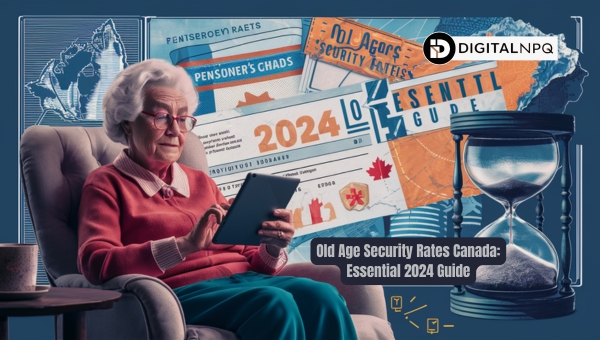Old Age Security Rates Canada: Essential 2024 Guide

Understanding the world of retirement benefits can be tricky, but understanding the old age security rates in Canada doesn’t have to be. In this article, we’ll break down everything you need to know about the Old Age Security (OAS) program—from eligibility criteria and application processes to payment structures and additional benefits.
We’ll also delve into the specifics of the OAS rates for 2024 and offer tips on maximizing your payments. Whether you’re planning for your future or helping a loved one, this guide will empower you with crucial information to make informed decisions. Let’s dive in!
Breaking Down the Old Age Security (OAS) in Canada
Navigating the Old Age Security (OAS) system in Canada can seem complex, but understanding it is crucial for those approaching retirement. OAS is a government program that provides monthly payments to eligible seniors.

This pension aims to help older Canadians meet their financial needs during retirement. To make the process clearer, we’ll delve into the eligibility criteria and how to apply for these benefits.
Eligibility Criteria for OAS
To qualify for the Old Age Security (OAS) pension in Canada, you must meet specific requirements:
- Age: You must be 65 years or older.
- Residency: You need to be a Canadian citizen or legal resident at the time your OAS application is approved.
- Residency Duration: You must have resided in Canada for at least 10 years after turning 18 if you currently live in Canada.
- Residency Outside Canada: If you live outside Canada, you must have resided in Canada for at least 20 years after turning 18.
It’s important to note that even if you don’t meet these criteria, you might still be eligible if you have lived in a country with a social security agreement with Canada.
How to Apply for OAS?
Applying for the Old Age Security pension involves a few straightforward steps:

- Automatic Enrollment: Some individuals are automatically enrolled. Service Canada will notify you if this is the case when you turn 64.
- Manual Application: If you are not automatically enrolled, you can apply online through your My Service Canada Account.
- Mail Application: Alternatively, you can download the application form from the Service Canada website and mail it in.
- Necessary Documents: Ensure you have essential documents like proof of age, Social Insurance Number (SIN), and proof of residency.
Following these steps will help you secure your OAS benefits smoothly and efficiently.
Also Read: CTC Payments 2024: Maximize Your Child Tax Credit
Understanding OAS Payments
When it comes to old age security rates in Canada, understanding how payments are structured is essential. Knowing the details can help you plan better for your retirement. Let’s delve into the various aspects of OAS payments to give you a clearer picture.

Benefit Payment Tables
The Old Age Security (OAS) payments are structured to provide financial support to seniors. These payments are often displayed in benefit tables for easy understanding. Here’s how they are typically structured:
- Age Group: Payments differ based on your age bracket.
- Monthly Amount: The specific amount you will receive each month.
- Annual Income: The income threshold that affects the payment amount.
Tables make it simple to see how much you’re eligible for based on various factors, such as age and income.
Old Age Security Pension Rates for 2024
For the year 2024, the OAS pension rates have been outlined clearly to help recipients plan their finances. Here is a summary of the rates:
- Ages 65 to 74:
- Monthly Payment: $718.33
- Ages 75 and Over:
- Monthly Payment: $790.16
These rates are subject to change based on quarterly adjustments, which are influenced by factors such as inflation.
Maximum Payments and Income Thresholds
The maximum OAS payments one can receive are determined by several factors, including residency and income. Here are the details:
- Maximum Monthly Payment:
- Ages 65 to 74: $718.33
- Ages 75 and Over: $790.16
- Income Thresholds:
- If your annual income exceeds $142,609 (ages 65 to 74) or $148,179 (ages 75 and over), your OAS payment may be reduced or even eliminated.
To receive the maximum payment, you must have resided in Canada for at least 40 years after the age of 18. If you have lived in Canada for less than 40 years, you might still qualify for a partial pension.
The amount you receive may also be influenced by your overall annual income, which determines whether your payments are subject to a reduction.
Understanding these details can help you maximize your benefits and ensure you are adequately prepared for your retirement years.
Additional OAS Benefits
Navigating the realm of Old Age Security (OAS) in Canada can be complex, but understanding the additional benefits available can be a game-changer.
Here, we delve into two crucial supplements: the Guaranteed Income Supplement (GIS) and the Allowance and Allowance for the Survivor. Let’s dive in to see who qualifies and how these benefits can enhance your OAS payments.
Guaranteed Income Supplement (GIS)
The Guaranteed Income Supplement (GIS) is designed to provide extra financial support to low-income seniors who are receiving the OAS pension. It’s a monthly payment that can significantly boost your overall income.
To qualify for GIS, you must:
- Be receiving the OAS pension.
- Be 65 years of age or older.
- Have an annual income below a specific threshold, which varies based on your marital status.
The GIS is not taxable, which means you get to keep the full amount without having to pay taxes on it. This supplement is recalculated every year based on your income, ensuring that you receive the appropriate amount each month.
Allowance and Allowance for the Survivor
The Allowance and the Allowance for the Survivor are additional benefits tailored for specific groups of low-income individuals. These allowances aim to provide financial stability to those who are closely linked to OAS recipients.
Allowance:
- Available to individuals aged 60 to 64.
- Must be the spouse or common-law partner of a GIS recipient.
- Must meet specific income requirements.
Allowance for the Survivor:
- Available to individuals aged 60 to 64.
- Must be the surviving spouse or common-law partner of a deceased GIS recipient.
- Must meet specific income requirements.
To apply for either of these allowances, you will need to submit a detailed application form along with the necessary documents, such as proof of income and marital status. The application process is straightforward, and assistance is available through Service Canada to help you every step of the way.
Also Read: VA Disability Pay Dates & New Rates Revealed
Adjustments and Increases to OAS Payments
Navigating the world of Old Age Security (OAS) payments can feel overwhelming, especially when understanding how and when these payments are adjusted. Let’s delve into the specifics to give you a clearer picture of what to expect.
When and How Payments Are Updated
OAS payments are updated quarterly, ensuring that the amounts keep pace with the cost of living. These updates occur in January, April, July, and October. The primary factor influencing these adjustments is the Consumer Price Index (CPI), which measures inflation.
If the cost of goods and services increases, so do the OAS payments. Conversely, if the cost of living decreases, the payments will remain the same. This ensures that seniors’ purchasing power is preserved over time. Legislative changes can also impact these payments, but these are less frequent and typically well-publicized.
Latest Payment Adjustment (July to September 2024)
For the period from July to September 2024, the OAS payments have seen the following adjustments:
- Maximum monthly payment for those aged 75 and over: $790.16
- Maximum monthly payment for those aged 65 to 74: $718.33
These adjustments reflect the recent changes in the Consumer Price Index, ensuring that seniors continue to receive an amount that aligns with the current cost of living.
Next Payment Adjustment (October to December 2024)
Looking ahead, the next quarterly adjustment will take place from October to December 2024. While the specific amounts have not yet been announced, it’s expected that any changes will be based on the latest inflation data and other economic factors.
This ensures that the payments remain fair and adequate for all recipients. Stay tuned for updates as the new figures are released.
Ways to Maximize Your OAS Payments
Maximizing your Old Age Security (OAS) payments can make a significant difference in your retirement income. Here are some detailed strategies and tips to help you get the most out of your OAS benefits:
Delaying Your OAS Pension
One effective way to maximize your OAS payments is by delaying your application.
Here’s how it works:
- Increase Your Monthly Payments: For every month you delay receiving your OAS pension beyond age 65, your payment increases by 0.6%. This can add up to a maximum increase of 36% if you defer your pension until age 70.
- Long-Term Benefit: Delaying your OAS can be particularly beneficial if you expect to live a longer life. The increased monthly payments can provide more financial security over the years.
- Consider Your Health and Financial Situation: Assess your health and financial needs before deciding to delay. If you are in good health and have other sources of income, delaying can be a wise choice.
Ensuring Residency Requirements
To receive the full OAS pension, you need to meet certain residency requirements:
- Minimum Residency: You must have lived in Canada for at least 40 years after turning 18 to qualify for the full OAS pension.
- Partial Pension: If you have lived in Canada for fewer than 40 years, you may still qualify for a partial pension. Each year of residency after age 18 counts towards your pension amount.
- Residency Outside Canada: If you live outside Canada, ensure you have lived in Canada for at least 20 years after age 18 to continue receiving OAS payments abroad.
Coordinating with Other Retirement Income Sources
Proper coordination of your OAS with other retirement income sources can help maximize your overall benefits:
- Canada Pension Plan (CPP): Consider how your OAS works with your CPP. Receiving both benefits can provide a more stable income during retirement.
- Private Pensions and Savings: Align your OAS with private pensions and savings plans. This coordination can help you maintain a steady cash flow and reduce your tax burden.
- Income Splitting: If you have a spouse or common-law partner, income splitting can help lower your taxable income. This strategy can be beneficial if one partner has a significantly higher income.
- Tax Implications: Be aware of the tax implications of your total income. Staying below certain income thresholds can help you avoid OAS clawbacks.
Utilizing Government Programs
Take advantage of additional government programs that can supplement your OAS:
- Guaranteed Income Supplement (GIS): If your income is low, you may qualify for the GIS, which provides additional financial support.
- Allowance and Allowance for the Survivor: These programs offer benefits to low-income individuals aged 60-64 who are spouses, common-law partners, or survivors of OAS recipients.
Regularly Reviewing Your Plan
Regularly review and adjust your retirement plan to ensure you are maximizing your OAS benefits:
- Stay Informed: Keep updated on any changes to OAS rates, income thresholds, and government policies.
- Consult a Financial Advisor: A financial advisor can provide personalized advice based on your unique situation, helping you make informed decisions.
By following these strategies, you can effectively maximize your OAS payments and enjoy a more financially secure retirement.
FAQs
Do I get my husband’s CPP if he dies?
Yes, you may receive a portion of your deceased spouse’s Canada Pension Plan (CPP) benefits. This is known as the CPP survivor’s pension and the amount depends on various factors including your age and the contributions made by your spouse.
How much is CPP per month?
The amount of CPP you receive per month varies based on your contributions and the age at which you start taking it. As of 2023, the maximum monthly amount for new recipients at age 65 is approximately $1,306.57.
How much is OAS in Canada per month?
The Old Age Security (OAS) pension in Canada pays up to $618.45 per month in 2023 for individuals aged 65 to 74. For those aged 75 and over, the maximum monthly payment is $648.67.
Conclusion
Understanding the Old Age Security rates in Canada is crucial for planning a secure retirement. Knowing the eligibility criteria, application process, payment structure, and additional benefits can help you make informed decisions. Staying updated on payment adjustments ensures you maximize your benefits.
With the right information, you can navigate the complexities of OAS with confidence. For more insightful articles and tips on retirement planning, be sure to explore other blogs on our site. Your journey to a secure retirement starts here!
